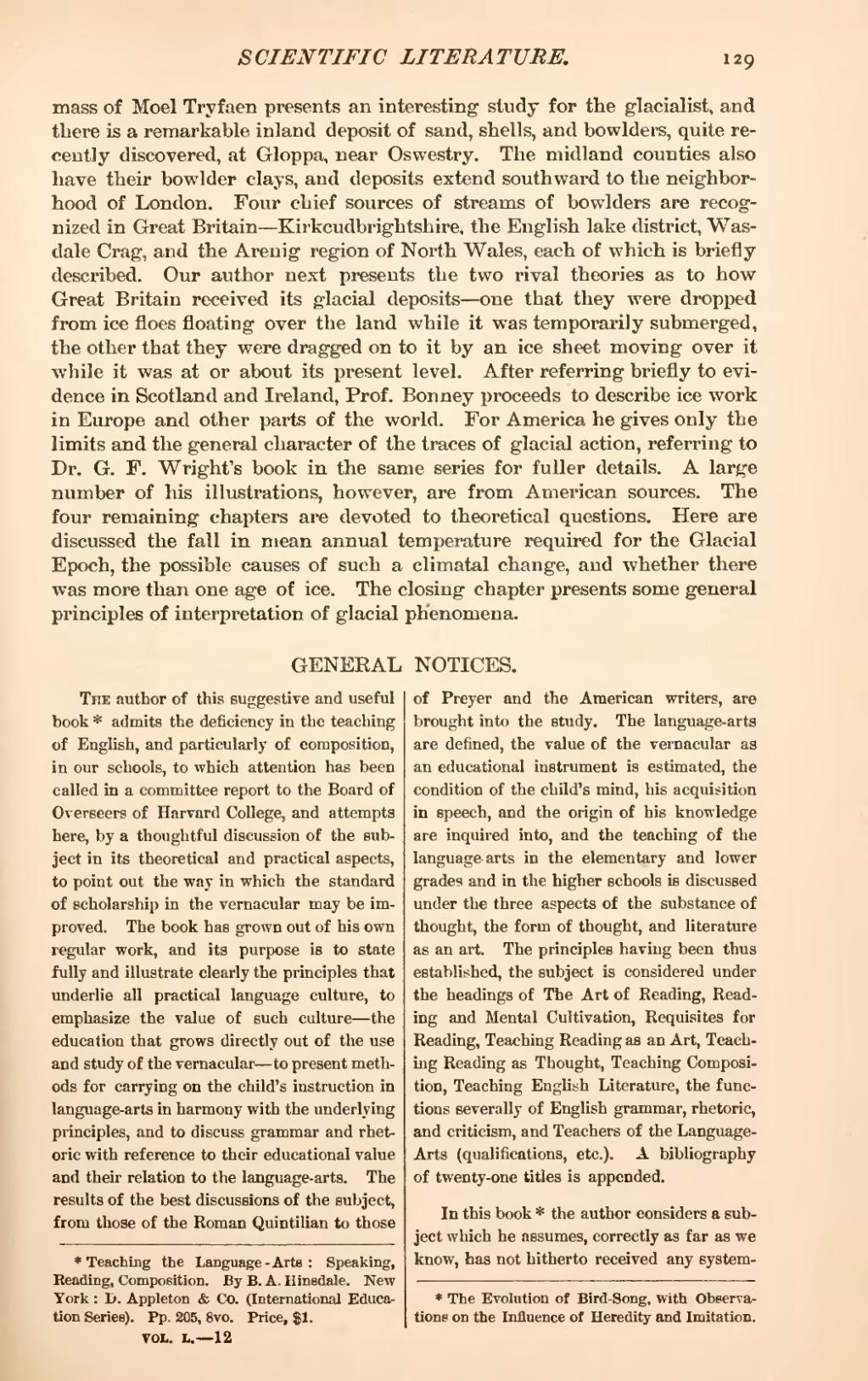mass of Moel Tryfaen presents an interesting study for the glacialist, and there is a remarkable inland deposit of sand, shells, and bowlders, quite recently discovered, at Gloppa, near Oswestry. The midland counties also have their bowlder clays, and deposits extend southward to the neighborhood of London. Four chief sources of streams of bowlders are recognized in Great Britain—Kirkcudbrightshire, the English lake district, Wasdale Crag, and the Arenig region of North Wales, each of which is briefly described. Our author next presents the two rival theories as to how Great Britain received its glacial deposits—one that they were dropped from ice floes floating over the land while it was temporarily submerged, the other that they were dragged on to it by an ice sheet moving over it while it was at or about its present level. After referring briefly to evidence in Scotland and Ireland, Prof. Bonney proceeds to describe ice work in Europe and other parts of the world. For America he gives only the limits and the general character of the traces of glacial action, referring to Dr. G. F. Wright's book in the same series for fuller details. A large number of his illustrations, however, are from American sources. The four remaining chapters are devoted to theoretical questions. Here are discussed the fall in mean annual temperature required for the Glacial Epoch, the possible causes of such a climatal change, and whether there was more than one age of ice. The closing chapter presents some general principles of interpretation of glacial phenomena.
The author of this suggestive and useful book[1] admits the deficiency in the teaching of English, and particularly of composition, in our schools, to which attention has been called in a committee report to the Board of Overseers of Harvard College, and attempts here, by a thoughtful discussion of the subject in its theoretical and practical aspects, to point out the way in which the standard of scholarship in the vernacular may be improved. The book has grown out of his own regular work, and its purpose is to state fully and illustrate clearly the principles that underlie all practical language culture, to emphasize the value of such culture—the education that grows directly out of the use and study of the vernacular—to present methods for carrying on the child's instruction in language-arts in harmony with the underlying principles, and to discuss grammar and rhetoric with reference to their educational value and their relation to the language-arts. The results of the best discussions of the subject, from those of the Roman Quintilian to those of Preyer and the American writers, are brought into the study. The language-arts are defined, the value of the vernacular as an educational instrument is estimated, the condition of the child's mind, his acquisition in speech, and the origin of his knowledge are inquired into, and the teaching of the language-arts in the elementary and lower grades and in the higher schools is discussed under the three aspects of the substance of thought, the form of thought, and literature as an art. The principles having been thus established, the subject is considered under the headings of The Art of Reading, Reading and Mental Cultivation, Requisites for Reading, Teaching Reading as an Art, Teaching Reading as Thought, Teaching Composition, Teaching English Literature, the functions severally of English grammar, rhetoric, and criticism, and Teachers of the Language-Arts (qualifications, etc.). A bibliography of twenty-one titles is appended.
In this book[2] the author considers a subject which he assumes, correctly as far as we know, has not hitherto received any system-
